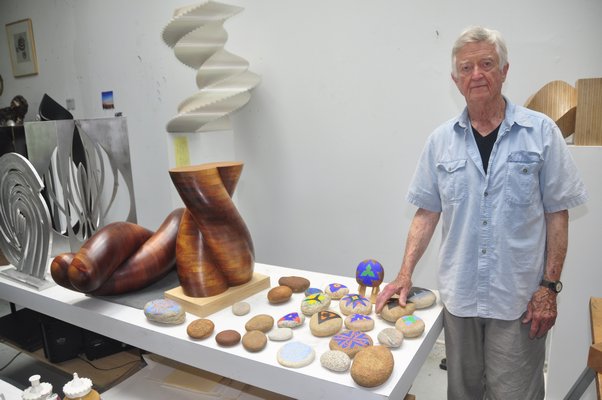
Jack Youngerman was 19 when he first saw the ocean.
He was stationed in Charleston, South Carolina, as a Navy officer-in-training through a program hosted by the University of North Carolina at Chapel Hill. It was there he took his first drawing class.
“I was interested,” the 87-year-old said last Tuesday afternoon. “I was proud when the teacher would pin up a drawing, one of my drawings. I was very proud. I got a lot of satisfaction, thinking I could do some small thing. That I could do something that was maybe interesting to somebody.”
By age 21, Mr. Youngerman was living in Paris, France. It was the fall of 1947, and after less than five years there, he opened a one-man exhibition at Galerie Arnaud—many more were to come for the abstract revolutionary.
“Before Paris, I didn’t know what painting was and I didn’t know what art was,” Mr. Youngerman said, “until I grew up and, out of curiosity, started going to museums to find out, ‘What is this stuff?’ That was my university, so to speak.”
He paused, adjusting his position on his stool while staring thoughtfully at the fields outside his Bridgehampton barn studio. “Amazing where life can take you.”
Mr. Youngerman was born on March 25, 1926, in St. Louis, Missouri, but spent his childhood living in Louisville, Kentucky. There were no beaches, no paintings and no art classes. Just horses, the “warm, muddy, Ohio River” and an unquenchable artistic thirst.
“I always, like a lot of kids do—like my 13-year-old son does—I drew little things on the margin of my books and papers and things,” Mr. Youngerman said. “But there was no formal instruction I could have done.”
Not until Paris. He studied academic drawing at Ecole des Beaux-Arts and returned to the United States in 1956, where he rented a house near Battery Park at Coenties Slip in Manhattan. He was stimulated by the busy sidewalks bustling with the young and energetic people, he said.
But still, he craved something else.
He wanted space. He wanted nature. He wanted water. So in 1968, he bought 4½ acres in Bridgehampton, even though the modest home on site—which had once operated as a farm—was boarded up and deteriorating, he said.
“The house was here with one small barn remaining. The other barns had fallen down,” he said. “It had been on the market for many years. Around here, there were only open fields, basically potato fields. That was sort of what I liked about it.”
The artist revamped the 1930s-era house, closing up the front and opening the back to the fields and a horse farm, he said. Then, its red façade was covered with cedar shingles that Mr. Youngerman’s wife, Hilary, added.
When the couple moved out to the East End full-time 15 years ago, they built an addition with an upstairs studio. That space, once used by Ms. Youngerman, has now been commandeered by their son, Milo. A master suite, which is personalized with a Tibetan Thangka scroll and a rug from the Moroccan Sahara hanging on the walls, was also added.
“Our house isn’t a newsworthy house,” Mr. Youngerman said. “It’s not a Hamptons mansion, and you can see the studio isn’t one of these super-studios, either. It’s a workspace and not a grand, artist studio-type place.”
The two-room, whitewashed barn studio is currently a retrospective, though not purposefully. East Hampton-based artist Janet Goleas is currently archiving his work, allowing Mr. Youngerman—who received the Guild Hall Lifetime Achievement Award in 2004—to delve into the storage and take a look back at his own art.
A row of paintings from the late 1950s and early ’60s sat propped against a wall in the back room. The artist’s work area in the front was littered with paintbrushes, colored pencils and stacks of colorful cut paper that often inspire him—an “organized mess,” he called it—as well as painted rocks and a collection of abstract sculptures that span four decades.
“I think that I started really at moments where I didn’t have any two-dimensional ideas at all,” he said of sculpture, “where I was empty and, out of almost desperation, I started working in three dimension. Just to try to do something else. And, actually, that’s true of most artists who do it. There’s a point where you want to change, work in a different medium.
“The sculptures, the reason they’re all around like this is, most of them were in storage and you forget that you’ve done them,” he continued. “I had the idea of getting most of them out and juxtapose them next to each other, just for myself to see how they would be close together.”
Today, some white resin and black resin sculptures created by Mr. Youngerman in the 1980s are now on view at LongHouse Reserve in East Hampton. Inspired by the East End dunes and waves, the artist once constructed them by twisting soft foam, tying it up and making a mold, which was then filled with resin, he said.
“In a way, I create my own inspiration,” he said. “I like things I see. I don’t use them in my work, directly, but I like looking at them, especially nature, natural forms. Yeah, that’s part of what I really like out here—the openness, the greenness and all the waters. It’s not a bad place to be.”
He walked across the lawn and paused to play with Windsor, the family’s 3-year-old Corgi. A pair of nearby horses looked up for a moment to watch and then went back to grazing as the artist disappeared into his studio and shut the door.